 |
 |
|
 |
Governor to give State of the State address Feb. 6 |
 |
 |
 |
The governor this week moved his State of the State address to Thursday
in the State Capitol (above) in deference to the memorial service scheduled
Tuesday for the astronauts aboard the space shuttle Columbia.
|
Originally scheduled for Tuesday, Gov. Tim Pawlenty this week postponed his
first State of the State address to Thursday in memory of those who lost their
lives in the Columbia shuttle tragedy.
A joint session of the Legislature convenes in the State Capitol on Feb. 6
at 11:45 a.m. The governor will begin his address at noon.
|
back

|
 |
Highway crews put mettle to the pedal against heavy snow |
 |
 |
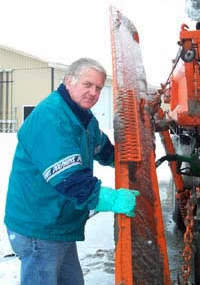 |
|
Duane Thorsvik, a transportation generalist at St. Cloud, checks his
snowplow after plowing during the first heavy snowfall in the region.
Photo by Mike Travis
|
Mn/DOT maintenance managers scrambled scores of snowfighters on Sunday night
and Monday morning to intercept the effects of a band of heavy, wet snow that
swept across the central and southern parts of the state.
The snowstorm covered the state’s mid-section, dropping as much as 13 inches
of snow from the western border eastward to the Twin Cities metro area. Heavy
compacted snow adhered to warm pavement while wind speeds of 35 miles an hour
blew snow around, cutting visibility.
Further south, ice plagued the tier of counties along the Iowa border and areas
such as Windom, Mankato and Rochester. Numerous crashes, spinouts and cars sliding
into the ditch were reported but none apparently caused death or serious injury.
No roads, however, were closed due to the storm.
The storm was the first major snowfall in the region that had been marked by
snow drought since winter began.
"Our guys were ready and they’re still out there, re-sanding and re-scraping
with the underbody plows to get down to the pavement," said Dean Olson,
maintenance superintendent, District 4, Morris maintenance area.
Dennis Marty, maintenance subarea supervisor, Willmar/District 8, said that
rapidly dropping temperatures slowed the effects of ice-melting chemicals. Crews
used underbody plows and motor graders to grind off the snow.
"We’re throwing all the iron at it that we can, but I believe it’s going
to be a couple of days before we get to bare pavement," he said.
Norm Ashfeld, Metro Division South Region supervisor, reported that anti-icing
on bridges, the I-394 HOV lane and other locations aided snow removal efforts
in the Twin Cities Metro region. After initially clearing snow, Ashfeld said
that Metro deployed about one-third of its crews to clear slush and snow from
highways before it could freeze.
Maintenance crews from the Windom maintenance area earned service stripes for
keeping major roads such as I-90 open while dealing with a changing mixture
of weather conditions. Tom Zimmerman, maintenance supervisor, Mankato/District
7, Windom maintenance area, praised crews’ efforts.
"We’ve had ice and freezing drizzle and whatnot, but our crews kept sanding
and salting to keep people on the road," he said.
By Craig Wilkins
Travelers flock to 511 during storm, commercial drivers get
better information
Internet users thronged to the 511 Traveler Information System, hitting the
Web site more than 1.2 million times during the storm and its aftermath as well
as more than tripling calls to the phone system.
From midnight Sunday, Feb. 2, through 10:30 a.m. on Monday, Feb. 3, the 511
telephone system received 7,545 calls. During non-storm periods, the system
receives from 1,000 to 2,000 calls each day, according to Ginny Crowson, Advanced
Traveler Information System coordinator, Traffic Engineering/ITS.
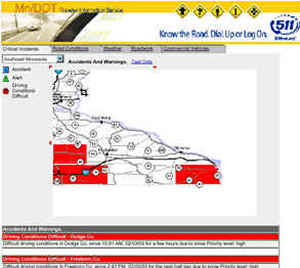 |
During bad weather, visitors to the 511 Web site can expect to see
warnings such as those pictured here.
|
During the storm and its aftermath, the 511 mn.org Web site received the following
"hits," Crowson said:
- Feb. 2: 348,384
- Feb. 3: 589,502
- Feb. 4: 315,838
The 511mn.org Web site now provides commercial vehicle operators with more
detailed information about overdimension permit restrictions. Moving overdimension
vehicles is very dependent upon weather, Crowson said, and easy access to information
about changes in restriction is critical. Both 511 and 511mn.org are making
access easier, she said.
For the first time, commercial vehicle operators could use a 511 page designed
specifically for them. The Web site now includes information about permits for
overdimension and overweight trucks as well as road and weather conditions.
"A severe storm changes the affected area to red and informs truckers
that permits they hold are not valid and that Mn/DOT will not issue any permits
until the emergency passes," said Deb Fick, condition acquisition reporting
system administrator, Traffic Engineering.
"The yellow code advises truckers to call in to make sure permits are
valid," she added. "Green means all permits are valid."
To access traveler information, call 511 or 800/657-3774 or 800/627-3529
(TTY, Voice, ASCII) or visit the Web site at http://www.511mn.org.
By Craig Wilkins
|
back

|
 |
Pre-qualification program marks change in contract practices |
 |
 |
Mn/DOT’s new pre-qualification program was announced in the Jan. 27 State Register.
Both prime and sub consultants must pre-qualify in certain program areas for
Mn/DOT highway-related contracts. Pre-qualification will eventually replace
most of the existing certified lists and T-contract programs.
"Pre-qualification will provide Mn/DOT a wider pool of consultants to select
from when we have projects," said Jeff Brunner, Technical Support. "This
new system will eventually apply to most consultant contracts. It guarantees
consultants consideration in their work type, but it doesn’t guarantee selection."
Brunner announced the changes at the annual American Council of Engineering
Companies/Mn/DOT meeting on Jan. 29.
The new system, part of Mn/DOT’s streamlining efforts, was in the works before
the governor
established the Mn/DOT Contract Management Team on Jan. 28. (See also the
Jan. 29 Mn/DOT Newsline
article.)
Districts and offices now execute consultant agreements necessary for their
programs. Brunner says 250 Mn/DOT employees have been trained so far. Once trained,
employees must successfully complete five contracts to be certified by the consultant
services staff. All contracts are signed by the Department of Administration.
Districts and offices now execute consultant agreements necessary for their
programs. Mn/DOT consultant contracts have increased dramatically since fiscal
year 1998 when 208 consultant contracts were executed. In FY 2001 and FY 2002,
Mn/DOT executed 852 and 641 consultant contracts respectively. The increase
is in response to a much larger program to deliver with no Mn/DOT staff increases.
"The new pre-qualification program will allow consultants to apply any time
for a particular work type," Brunner said. "Consultants will be notified of
their application results within 30 days of application. Once qualified, they
are on the list for two years unless suspended."
For contracts less than $100,000, districts and offices can select from pre-qualified
consultants for the work type. Contracts higher than that will be advertised
on the Mn/DOT Web site and require a letter of interest from consultants; selection
will be by committee. The largest contracts—those worth more than $800,000—require
a letter of interest. Three to five pre-qualified consultants will be selected
or "short-listed" and asked to submit formal proposals.
"The new system should save consultants time and money since they don’t have
to prepare proposals for every contract," said Brunner. "The new program should
also save Mn/DOT money because consultant overhead costs will be lessened."
Initially, consultants in the areas of design, project development/preliminary
design, bridge design, bridge inspection and environmental studies can apply.
Additional work types will open for application in February and March.
More information is available on the pre-qualification Web site at: http://www.dot.state.mn.us/consult/files/prequal/front.html.
By Sue Stein
|
back

|
 |
Terrorism prevention remains high priority for task force, agency |
 |
 |
 |
The nation has been at the "yellow" (elevated threat) level
since the system was put established after the Sept. 11, 2001 tragedy.
Graphic from U.S. Department of Homeland Security
|
The Federal Highway Administration recently chose Mn/DOT as one of four transportation
departments nationwide to host a workshop on emergency transportation operations
preparedness and response, according to Mike Sobolewski, Mn/DOT’s transportation
security analyst.
"We’re excited to play host to this workshop, which is tentatively scheduled
for late spring or summer. It reflects Mn/DOT’s leadership in the security arena
and will help develop the model for others," said Sobolewski, who also
sits on the American Association of State Highway and Transportation Officials
Transportation Security Task Force.
Common sense is best defense against terrorism
The threat of terrorism in Minnesota may seem remote, according to Mn/DOT’s
Security Task Force, but preparation for and increased alertness to terrorists
are still important on the local level.
"Our best defense against terrorism is common sense," said Bruce
Biser, security task force chair. "If you see something out of the ordinary—report
it."
For instance, if a small truck is stalled alongside a roadway adjacent to a
cornfield, it is probably nothing, Biser said.
"However, if that same truck were stalled alongside the roadway adjacent
to a power plant, it should raise some questions and be reported to the proper
authorities."
Employees should also look at ordinary tools and resources in light of their
potential use by a terrorist.
"Just think how easy it would be for a terrorist in a large orange truck
with a Mn/DOT logo on it to gain access to just about anywhere with no questions
asked," Biser said.
"Increased alertness and attention to procedures—such as locking up vehicles
and facilities—is more important than ever in the volatile world situation we
face today."
Districts conduct vulnerability assessments
Each Mn/DOT district and Metro Division has appointed a security task force
to conduct vulnerability assessments that will be completed by March. For now,
these teams will also be the focal point for any security issues, directives
or changes in their area.
"One of the most important jobs for the local teams is to develop the
actions to be implemented as the security posture changes. They will give specific
direction to employees for each threat level. Mn/DOT’s security task force will
provide coordination with the rest of the agency," said Biser.
Information resources
Mn/DOT’s task force continuously connects with federal, state and local agencies
to keep abreast of the latest developments and transportation standards that
would help Mn/DOT respond to or prevent potential threats. Resources used include:
The Homeland Security Advisory System is color-coded to indicate threat level:
Low = Green; Guarded = Blue; Elevated = Yellow; High = Orange; Severe = Red.
The nation has been at the "elevated" level since the system was established
after the Sept. 11, 2001 tragedy. The exception was during the week surrounding
the tragedy’s one-year anniversary, when the threat was coded as "high."
This system creates a common method to indicate the nature of threats and the
appropriate responses at each level.
"When we are notified of a change in threat condition we will notify employees
who need to take specific actions according to the level," said Tom Barna,
security task force member and Mankato/District 7 security manager. "Each
district may have actions unique to their area, so it is important that employees
rely on their local team for information."
For more information about Mn/DOT’s Security Task Force contact Biser, 651/297-8316,
or Sobolewski, 651/297-5149. Other information sources include the StarTribune,
which keeps a Web site of news
articles relating to terrorism and the Minnesota Legislature’s links
to other organizations and government agencies.
By Lucy Kender |
back

|
 |
Huseby resigns as Mankato district engineer |
 |
 |
Jon Huseby, Mankato/District 7 district engineer, announced his resignation
this week to accept a position in the private sector. His resignation becomes
effective Feb. 7.
Greg Ous, assistant district engineer, Program Delivery, will serve as acting
district engineer until a permanent successor to Huseby is selected.
Huseby was appointed as district engineer in 1998. Before his appointment,
he served as an assistant district engineer with Willmar/District 8 managing
design, traffic, land use and materials testing and held a similar post with
the Mankato District from 1993 until 1998. Huseby also served in various postions
in the Central Office and with the Metro Division.
As district engineer, Huseby provided leadership for projects including completion
of the four-lane section of Hwy 60 from Windom to Worthington and expansion
of Hwy 14 around Eagle Lake and future programming for expansion to Waseca.
A Montevideo native, Huseby holds a bachelor’s degree in civil engineer from
North Dakota State University.
|
back

|
 |
Electronic bidding saves $60,000 in its first year |
 |
 |
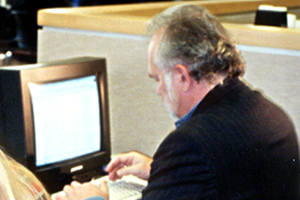 |
Gary Ericksen kicked off Mn/DOT's successful e-bidding program in January
2002. Photo by Marsha Storck
|
The results are in now for one cost-saving, streamlining initiative that Mn/DOT
began 12 months ago, and the news is encouraging: Mn/DOT saved approximately
$60,000 in its first year of electronic bidding.
Mn/DOT moved to electronic bidding in January 2002 and became one of the first
states in the nation to use this program that allows contractors to submit bids
for construction projects over the Internet.
Electronic bidding eliminates travel time for contractors who bid online, which
improves both the efficiency of the contractor’s bidding practices and timely
deliveries of bids. E-bidding also eliminates errors by use of safeguards that
alert contractors to data entry errors and incomplete forms. This provides better
value for taxpayers by ensuring that the most competitive bidder gets the job.
"State and federal laws require Mn/DOT to reject lowest bids if they contain
errors," said Gary Ericksen, Construction and Contract Administration.
"In one instance, the cost to award the contract to the next bidder meant
a million-dollar difference."
Last year Mn/DOT accepted more than 800 bids for construction projects and
awarded more than 270 construction contracts. Contractors electronically submitted
about 40 percent of these, which accounted for about 65 percent of the dollars
spent on construction projects. Mn/DOT still accepts hard copy bids as well.
Besides saving taxpayers’ money, e-bidding simplifies the bidding process for
contractors. The system does the calculations for contractors and also allows
them to submit bids at the last minute before deadline. Contractors can skip
the drive to deliver their bids and stay in their offices obtaining quotes from
subcontractors who’d assist them on projects.
"We’d like to see all contractors using this process for the next construction
season," Ericksen said. "We know that it results in more competitive
pricing and that’s a better value for our tax dollars."
By Daneeka Marshall-Oquendo
|
back

|
 |
Discussions with Bob focuses on employee concerns |
 |
 |
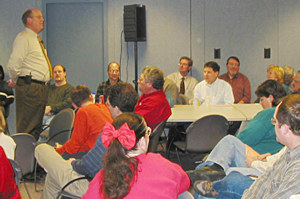 |
Metro Division Engineer Bob Winter fielded a number of hot questions
from Metro employees during the noon hour brown bag session on Jan 27.
Photo by Kent Barnard
|
In his first installment of Discussions with Bob since the November election,
Metro Division Engineer Bob Winter fielded a number of hot questions from Metro
employees during the noon hour brown bag session on Jan. 27. Topics included
the new administration, the state’s looming budget deficit and a series of negative
articles in the Star Tribune.
Touching on those Star Tribune articles, Winter reminded employees that
everything we do is in the public eye and e-mails are not private conversations.
Questions from the audience covered current proposals to eliminate the Highway
Helper program, establish early retirement incentives and require mandatory
time off without pay for employees.
Additional Discussions with Bob will take place at several Metro Division locations
throughout the year. The next session is on Feb. 20 at the Lakeville Truck Station.
For more information on this and other topics, visit Metro’s online employee
newsletter at http://ihub.metro.dot.state.mn.us/newsletter.
Other district newsletters available online include:
By Kent Barnard
|
back

|
 |
Mn/DOT reviews information management process |
 |
 |
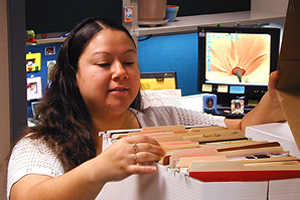 |
Deloris Bryand inventories files as part of Mn/DOT’s document retention
and information management efforts. Photo by David Gonzalez
|
An intensive effort to inventory all of Mn/DOT’s stored information begins
this month, with the Office of Information Resource Management taking the lead.
OIRM staff have finished a two-month test pilot of their plan and have begun
meeting with employees in several Mn/DOT offices to inventory all information
that the department has received, created and stored—including electronic applications
and databases.
According to the Minnesota Records Retention Act, a state agency must retain
data for a specific period of time. With this review process, Mn/DOT can determine
a retention schedule for all information and provide an orderly and accountable
disposition process for the agency.
"Once we’ve identified the types of material each office and district
creates, we can have a better idea of how to effectively use our technology
to manage Mn/DOT information," said Deloris Bryand, records retention specialist.
"I’ll be contacting managers to schedule an appointment for their area."
Bryand said the inventory is the foundation of a consistent document management
system. The inventory is also part of Mn/DOT’s streamlining efforts to operate
more efficiently. Ultimately, it can help increase productivity, provide shared
access to documents, and improve document management security and retention.
It will also improve how quickly Mn/DOT responds to data practices requests.
"As with any initiative, these benefits will be recognized with time and
with a commitment in changing the way we do business," Bryand added.
Bryand plans to complete the inventory in about one year.
For more information regarding the inventory process and records retention
issues, contact Bryand via GroupWise or at 651/284-3558.
By Daneeka Marshall-Oquendo
|
back

|
 |
Keep up with department's news, views |
 |
 |
Each district posts news releases of local interest on their Web sites as well
as links to statewide news releases on Mn/DOT’s News and Views Web site. To
view current Mn/DOT statewide news releases, visit: http://www.dot.state.mn.us/news.html.
To view current news releases, visit the following Web sites:
Duluth/District 1: http://www.dot.state.mn.us/d1/news.html
Bemidji/District 2: http://www.dot.state.mn.us/d2/news.html
Brainerd/District 3: http://www.dot.state.mn.us/d3/news.html
Detroit Lakes/District 4: http://www.dot.state.mn.us/d4/news.html
Rochester/District 6: http://www.dot.state.mn.us/d6/news.html
Mankato/District 7: http://www.dot.state.mn.us/d7/news.html
Willmar/District 8: http://www.dot.state.mn.us/d8/news.html
Metro Division: http://www.dot.state.mn.us/metro/news/
|
back

|
 |
|
 |



